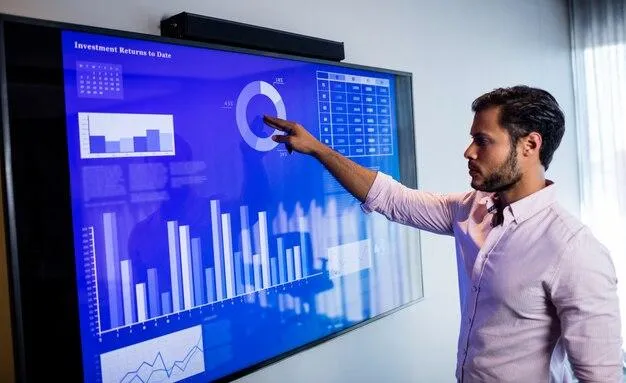BLOGS

Maximizing Learning Potential: The Impact of Smart Digital Boards in Modern Classrooms
In the ever-evolving landscape of education, technological advancements continue to shape the way students learn and teachers teach. Among these innovations, smart digital boards stand out as transformative tools, ushering classrooms into a new era of interactive and dynamic learning experiences.
Smart digital boards, also known as interactive whiteboards or electronic display boards, represent a departure from traditional methods of instruction. Gone are the days of static chalkboards and one-dimensional lectures. Instead, these sleek, touchscreen displays offer a multimedia platform where educators can seamlessly integrate a variety of content — from vibrant images and immersive videos to interactive simulations and real-time data feeds.
In this blog, we will understand the profound impact of smart digital boards on modern classrooms and explore how they maximize the learning potential of students.
So, without further ado, let's discover how these cutting-edge tools are reshaping the educational landscape and paving the way for a more dynamic and enriching learning environment for students worldwide.
Advantages of Smart Digital Boards
A. Enhanced Visual Learning
⦁ Ability to display multimedia content: Smart digital boards empower educators to go beyond traditional text-based instruction by integrating multimedia elements such as images, videos, animations, and interactive graphics. This multi-sensory approach enhances comprehension and retention, catering to diverse learning styles within the classroom.
⦁ Engaging visual presentations: With vibrant and dynamic displays, smart digital boards captivate students' attention and create an immersive learning environment. Visual aids such as charts, graphs, and diagrams come to life, making complex concepts more accessible and stimulating curiosity.
B. Interactivity
⦁ Touchscreen functionality: The touchscreen interface of smart digital boards facilitates hands-on interaction, allowing students to directly engage with the lesson material. Whether it's dragging and dropping elements, annotating content, or solving interactive quizzes, the tactile nature of touchscreen technology promotes active learning and enhances student participation.
⦁ Interactive learning activities: Smart digital boards enable educators to design interactive lessons that encourage exploration, experimentation, and problem-solving. From virtual labs and simulations to interactive storytelling and educational games, these engaging activities foster critical thinking skills and deepen understanding through experiential learning.
C. Customization and Adaptability
⦁ Tailoring content to individual student needs: Smart digital boards offer unparalleled flexibility in adapting lesson content to meet the diverse needs and learning paces of students. Educators can personalize instruction by adjusting the pace, level of difficulty, and content delivery methods, ensuring that each student receives tailored support and enrichment opportunities.
⦁ Real-time updates and flexibility in lesson delivery: Unlike traditional teaching materials, digital content on smart boards can be easily updated and modified in real-time. This flexibility allows educators to respond to student feedback, incorporate current events or relevant resources, and seamlessly adjust lesson plans to accommodate unexpected changes or opportunities for deeper exploration.
D. Collaboration
⦁ Group projects and cooperative learning: Smart digital boards facilitate collaborative learning experiences by providing a shared platform for students to collaborate on group projects, presentations, and discussions. Through collaborative activities, students develop teamwork, communication, and problem-solving skills while leveraging the interactive features of the board to brainstorm ideas, share perspectives, and co-create knowledge.
⦁ Interactive discussions and brainstorming sessions: Smart digital boards transform traditional lectures into dynamic and interactive discussions, where students actively contribute to the learning process. Interactive brainstorming sessions, concept mapping exercises, and peer-to-peer feedback sessions foster a culture of inquiry and collaboration, empowering students to construct meaning collaboratively and deepen their understanding of complex concepts.
Supporting Different Learning Styles
Smart digital boards cater to diverse learning styles, providing visual learners with dynamic visual aids and interactive diagrams/charts. For kinesthetic learners, touchscreen functionality facilitates hands-on activities and interactive simulations/virtual labs, fostering experiential learning. Auditory learners benefit from multimedia presentations featuring audio components and access to podcasts/recorded lectures, engaging their auditory senses for enhanced comprehension. By accommodating various learning preferences, smart digital boards promote inclusivity and equitable learning experiences in the classroom.
Future Trends
⦁ Augmented Reality (AR) Integration: As AR technology becomes more advanced and accessible, smart digital boards may incorporate augmented reality features to create immersive learning experiences. Students could interact with virtual objects overlaid onto real-world environments, enhancing understanding and engagement.
⦁ Artificial Intelligence (AI) Assistance: AI-driven functionalities may further support personalized learning on smart digital boards, providing tailored recommendations, adaptive feedback, and intelligent content suggestions based on individual student data and learning patterns.
⦁ IoT Integration: Integration with the Internet of Things (IoT) could enable smart digital boards to connect with other classroom devices and systems, facilitating seamless data sharing, automation of routine tasks, and enhanced classroom management.
⦁ Enhanced Collaboration Tools: Future smart digital boards may offer advanced collaboration features, allowing students to collaborate in real-time across different devices and locations, fostering teamwork and communication skills in increasingly interconnected learning environments.
Conclusion
The evolution of smart digital boards represents a significant advancement in educational technology, revolutionizing traditional teaching practices and shaping the future of classroom learning. By enhancing engagement, personalizing instruction, and providing immediate feedback, these innovative tools empower educators to create dynamic and interactive learning experiences that cater to the diverse needs of students.
As technology continues to evolve, the future holds exciting possibilities for smart digital boards.
Copyright 2024 Company. All rights reserved. Various trademarks held by their respective owners.






